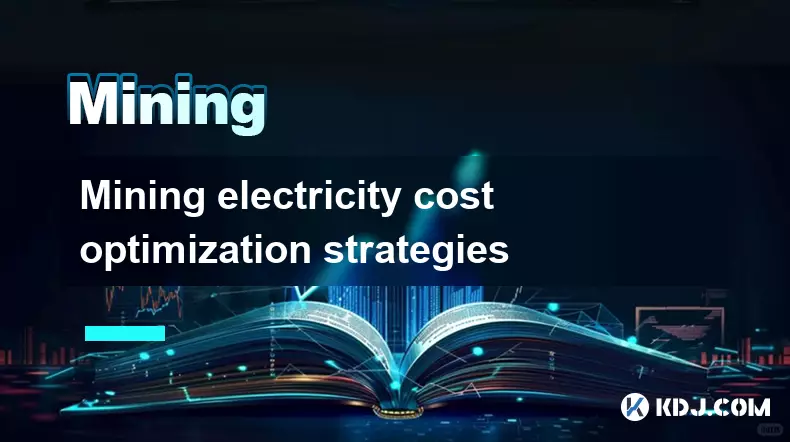-
 bitcoin
bitcoin $112195.049338 USD
2.42% -
 ethereum
ethereum $4124.915858 USD
2.81% -
 tether
tether $1.000570 USD
0.02% -
 xrp
xrp $2.861568 USD
2.25% -
 bnb
bnb $1000.346670 USD
3.04% -
 solana
solana $209.070819 USD
3.38% -
 usd-coin
usd-coin $0.999870 USD
0.02% -
 dogecoin
dogecoin $0.235379 USD
2.65% -
 tron
tron $0.335681 USD
-0.20% -
 cardano
cardano $0.803501 USD
3.38% -
 hyperliquid
hyperliquid $47.120881 USD
3.56% -
 chainlink
chainlink $21.501300 USD
3.44% -
 ethena-usde
ethena-usde $1.000571 USD
0.02% -
 avalanche
avalanche $29.793378 USD
3.62% -
 stellar
stellar $0.366964 USD
2.42%
Mining electricity cost optimization strategies
Strategic relocation, undervolting, and renewable energy integration can cut mining electricity costs by up to 40%, boosting long-term profitability.
Sep 22, 2025 at 03:55 pm

Mining Electricity Cost Optimization Strategies
1. Selecting regions with lower electricity tariffs is one of the most effective ways to reduce mining operational costs. Countries or provinces that generate surplus hydroelectric, geothermal, or wind energy often offer extremely low electricity prices during off-peak periods. Mining farms established in such areas can operate at a fraction of the cost compared to those in urban centers. Some operators have relocated entire facilities from high-cost zones to remote locations near power plants or dams where energy is abundant and underutilized.
2. Utilizing stranded or curtailed energy sources provides both economic and environmental advantages. In certain regions, renewable energy production exceeds grid absorption capacity, leading to energy being wasted. Cryptocurrency miners can partner with local energy providers to consume this excess power at minimal rates. This not only reduces electricity expenses but also supports sustainable energy use by preventing waste.
3. Implementing time-based mining schedules allows operators to align their hash power with off-peak electricity pricing. Many utility companies apply dynamic pricing models, where rates drop significantly during nighttime or periods of low demand. By configuring mining rigs to run at full capacity during these windows and scaling down during peak hours, miners improve cost efficiency without sacrificing long-term output.
4. Investing in on-site renewable energy infrastructure, such as solar panels or small-scale wind turbines, enables partial or complete energy independence. Although initial setup costs are substantial, long-term savings and insulation from market price fluctuations make this option increasingly attractive. Hybrid systems combining grid power with self-generated renewable energy offer flexibility and redundancy.
5. Negotiating customized power contracts with utility providers can yield significant discounts for large-scale operations. Miners running industrial-sized farms may qualify for bulk pricing agreements or special incentives aimed at stabilizing regional grids. These contracts often include clauses allowing temporary shutdowns during high-demand periods in exchange for reduced rates—ideal for non-time-critical mining workloads.
Hardware Efficiency and Energy Consumption
1. Upgrading to next-generation ASIC miners ensures higher computational output per watt consumed. Modern mining hardware like the latest Bitmain or MicroBT models deliver superior hashrates while maintaining lower thermal design power (TDP). Replacing outdated equipment reduces overall electricity demand and increases profitability margins even under stable coin valuations.
2. Regular maintenance and cleaning of mining devices prevent overheating and inefficiency. Dust accumulation and poor airflow increase power consumption and shorten component lifespans. Scheduled inspections, fan replacements, and thermal paste reapplication help maintain optimal operating conditions and energy efficiency.
3. Undervolting ASIC miners can drastically cut power usage without proportionally reducing performance. By fine-tuning voltage settings through firmware modifications, operators achieve a balance between stability and energy savings. This technique requires technical expertise but often results in 15–25% lower power draw across large fleets.4. Deploying liquid cooling systems enhances thermal management and allows sustained operation at higher efficiencies. Immersion cooling, in particular, submerges hardware in non-conductive fluids, dissipating heat more effectively than air-based solutions. Cooler components operate more efficiently and are less prone to throttling, which preserves consistent hash output over time.
5. Centralized monitoring tools enable real-time tracking of power usage effectiveness (PUE) across mining pools or data centers. These platforms identify underperforming units, detect anomalies, and recommend adjustments to maximize energy-to-output ratios. Automation scripts can shut down inefficient rigs during unfavorable market conditions.
Geographic and Operational Relocation Tactics
1. Cold climate regions offer natural advantages for cooling-intensive operations. Countries like Canada, Russia, Iceland, and parts of Scandinavia provide consistently low ambient temperatures, reducing reliance on artificial cooling systems. This translates into direct savings on HVAC electricity consumption.
2. Establishing modular mining containers allows rapid deployment and relocation based on seasonal energy pricing. These portable units can be moved to take advantage of temporary low-cost energy deals or short-term contracts in underutilized industrial zones. Mobility adds strategic flexibility to long-term cost planning.
3. Partnering with local industries that produce excess heat or require additional load balancing creates symbiotic relationships. Data centers can be hosted within manufacturing plants, using waste heat for facility warming while providing steady electrical demand to stabilize the host’s energy profile. Such arrangements often come with subsidized or free power access.
4. Leveraging tax incentives and regulatory exemptions in crypto-friendly jurisdictions amplifies savings beyond just electricity. Some countries offer zero VAT on imported hardware, no corporate income tax for blockchain ventures, or discounted utility rates for registered mining entities. Comprehensive financial planning includes evaluating these indirect benefits alongside direct power costs.
5. Forming mining collectives or cooperatives enables shared infrastructure and pooled negotiation power. Groups of independent miners can jointly lease land, install transformers, and secure dedicated transmission lines at lower per-unit costs than individual actors. Collective bargaining strengthens leverage when dealing with energy suppliers.
Frequently Asked Questions
What is undervolting in cryptocurrency mining?Undervolting refers to adjusting the voltage supplied to mining hardware below factory defaults while maintaining stable operation. It reduces power consumption and heat generation, improving energy efficiency without significantly compromising hashrate.
How does immersion cooling benefit mining farms?Immersion cooling involves submerging mining rigs in dielectric fluid that absorbs and transfers heat more efficiently than air. This method lowers operating temperatures, reduces dust-related failures, and decreases reliance on noisy and energy-intensive fans and AC units.
Can residential miners compete with industrial operations on electricity costs?Residential miners typically face higher per-kWh rates and lack access to bulk infrastructure. While small-scale setups can remain profitable during bull markets, they struggle to sustain margins under high electricity costs unless leveraging off-peak tariffs or home-generated solar power.
Why do some miners move operations seasonally?Seasonal migration allows miners to follow favorable energy conditions—such as summer hydropower surpluses in Sichuan or winter wind availability in Texas. Temporary deployments in these regions let operators capitalize on short-term low-cost power before relocating as conditions change.
Disclaimer:info@kdj.com
The information provided is not trading advice. kdj.com does not assume any responsibility for any investments made based on the information provided in this article. Cryptocurrencies are highly volatile and it is highly recommended that you invest with caution after thorough research!
If you believe that the content used on this website infringes your copyright, please contact us immediately (info@kdj.com) and we will delete it promptly.
- Solana at $197: Hunting for High-ROI Tokens in the Crypto Jungle
- 2025-09-30 03:05:17
- Mike Novogratz's XRP U-Turn: From Underestimated to Undeniable
- 2025-09-30 03:05:17
- SANDchain, Token Launchpads, and the Sandbox: Riding the Web3 Wave
- 2025-09-30 03:18:35
- Axl Rose's Graphic Novel: Can He Save Humanity From Paradise City?
- 2025-09-30 02:45:11
- Predictive Oncology's Bold Leap: AI, Digital Assets, and a Treasury Strategy Revolution
- 2025-09-30 03:18:35
- Axl Rose's 'Appetite for Destruction' Gets a Graphic Novel Makeover!
- 2025-09-30 02:45:11
Related knowledge

The difference between staking and mining
Sep 24,2025 at 05:18am
Understanding Staking in the Cryptocurrency Ecosystem1. Staking involves holding funds in a cryptocurrency wallet to support the operations of a block...

How to participate in testnet mining?
Sep 22,2025 at 09:18am
Understanding Testnet Mining in the Crypto Ecosystem1. Testnet mining is a method used by blockchain developers to simulate real-world conditions on a...

How to dispose of abandoned mining machines?
Sep 19,2025 at 08:19pm
Assessing the Condition of Abandoned Mining Rigs1. Begin by inspecting each mining machine for visible damage, corrosion, or missing components. Machi...

How to identify high-quality mining pools?
Sep 21,2025 at 03:19pm
Reputation and Track Record1. A mining pool’s reputation is built over time through consistent performance and transparency. Pools that have operated ...

Advantages of decentralized mining pools
Sep 20,2025 at 04:36pm
Enhanced Security and Resistance to Censorship1. Decentralized mining pools operate on blockchain-based smart contracts, eliminating the need for a ce...

What is mining machine overclocking?
Sep 21,2025 at 07:19pm
Understanding Mining Machine Overclocking1. Mining machine overclocking refers to the process of increasing the operating frequency of a cryptocurrenc...

The difference between staking and mining
Sep 24,2025 at 05:18am
Understanding Staking in the Cryptocurrency Ecosystem1. Staking involves holding funds in a cryptocurrency wallet to support the operations of a block...

How to participate in testnet mining?
Sep 22,2025 at 09:18am
Understanding Testnet Mining in the Crypto Ecosystem1. Testnet mining is a method used by blockchain developers to simulate real-world conditions on a...

How to dispose of abandoned mining machines?
Sep 19,2025 at 08:19pm
Assessing the Condition of Abandoned Mining Rigs1. Begin by inspecting each mining machine for visible damage, corrosion, or missing components. Machi...

How to identify high-quality mining pools?
Sep 21,2025 at 03:19pm
Reputation and Track Record1. A mining pool’s reputation is built over time through consistent performance and transparency. Pools that have operated ...

Advantages of decentralized mining pools
Sep 20,2025 at 04:36pm
Enhanced Security and Resistance to Censorship1. Decentralized mining pools operate on blockchain-based smart contracts, eliminating the need for a ce...

What is mining machine overclocking?
Sep 21,2025 at 07:19pm
Understanding Mining Machine Overclocking1. Mining machine overclocking refers to the process of increasing the operating frequency of a cryptocurrenc...
See all articles


























![[Pycoin] PI Coin -Shocking Listance of Pycoin?! 'Rebellion' This time ... Pay attention to #paikoin [Pycoin] PI Coin -Shocking Listance of Pycoin?! 'Rebellion' This time ... Pay attention to #paikoin](/uploads/2025/09/29/cryptocurrencies-news/videos/pycoin-pi-coin-shocking-listance-pycoin-rebellion-time-pay-attention-paikoin/68da82f23cec1_image_500_375.webp)















































